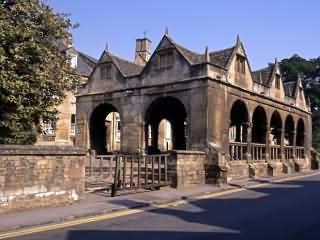 |
| The Local Time is Saturday, 27-Jul-2024 17:39:36 CEST |
Chipping Campden Tourist Information and Travel Guide |
|
|||
| YOU ARE HERE: Main Home Page > Places to Visit > Chipping Campden |
|
||
|
||
|
||
Chipping Campden Tourist Information GuideChipping Campden is one of the loveliest small towns in the Cotswolds and a gilded masterpiece of limestone and craftsmanship. The main street curves in a shallow arc lined with a succession of ancient houses each grafted to the next but each with its own distinctive embellishments. Pevsner described Chipping Campden as ‘the best piece of townscape As the name suggests ("Chipping" means market or market place from the old English "Ceping"). Chipping Campden was one of the most important of the medieval wool towns and famous throughout Europe. This legacy of fame and prosperity is everything that give the town its character. |
|||||||||||||||||||||||||||||||||||||||||||||||||||||||||
 |
Chipping Campden has become known for its unusual and attractive High Street, said by G.M. Trevelyan (English Historian) to be "the most beautiful village street now left on the island". The High Street is long and broad, and is flanked on either side by an almost unbroken single terrace, made up of many different architectural styles. |
||||||||||||||||||||||||||||||||||||||||||||||||||||||||
 |
This house is the oldest in Chipping Campden and was built by William Grevel in about 1380. The house would have been one of the first to have chimneys instead of just holes in the roof. Chipping Campden's wealth came from the Wool Trade. |
||||||||||||||||||||||||||||||||||||||||||||||||||||||||
 |
St James church is one of England's finest Wool Churches Featured with four stars in 'England's Thousand Best Churches' by Simon Jenkins". With pinnacles topping the diagonal buttresses and a pierced parapet with ogee arches, the composition soars over the landscape. Most of the church is 500 years old and was built with money from the flourishing wool trade. Each of the lime trees leading from the main entrance to the porch represent an apostle |
||||||||||||||||||||||||||||||||||||||||||||||||||||||||
 |
The ancient Market Hall was built in 1627 by Sir Baptist Hicks for a cost of £90.00. It was for the purpose of giving shelter to the local market selling cheese, butter and poultry - not wool as is sometimes thought. Each corner of the building has a pediment, and each gable had a window which is now blocked up. The side arches have stone balustrades and the floor is paved with stone. More information on Sir Baptist Hicks |
||||||||||||||||||||||||||||||||||||||||||||||||||||||||
 |
The Alms Houses were built in 1612 for £1000 by Sir Baptist Hicks in the form of a capital I and their simple style shows the early influence in Britain of the Renaissance. They were and still are used as the homes of twelve pensioners. Each dwelling has an upper and lower room and each front door is shared by two houses. Sir Baptist Hicks's coat of arms and motto "NONDVM METAM", meaning 'I shall not fear yet' can be found on the Alms Houses. |
||||||||||||||||||||||||||||||||||||||||||||||||||||||||
|
|||||||||||||||||||||||||||||||||||||||||||||||||||||||||
|
|||||||||||||||||||||||||||||||||||||||||||||||||||||||||
For many visitors, Chipping Campden is the quintessential Cotswold town. It has a variety of building styles that have survived from all ages. Chipping Campden was one of the Cotswold's main wool markets. Chipping Campden has important links with the Arts and Crafts movement. C.R. Ashbee set up his Guild of Handicrafts here in 1902. His workshop in the old silk mill in Sheep Street is now a small museum. Read the strange story of a mother and her two sons in the 1600's being hanged for a murder that never happened - known as 'The Campden Wonder'. NB: Please note American visitors quite often incorrectly spell Campden as 'Camden'. Visiting Famous Gardens There are several famous gardens within 15 minutes car journey of Chipping Campden including Hidcote Manor, Snowshill Manor, Bourton House, Sezincote, Hidcote Manor, Kiftsgate Court and Batsford Arboretum. See - Cotswold Gardens and North Cotswold Gardens Map and Driving Directions. |
|||||||||||||||||||||||||||||||||||||||||||||||||||||||||
 Ink Sketch of Chipping Campden by Richard Grassi |
|||||||||||||||||||||||||||||||||||||||||||||||||||||||||
 Watercolour of Ancient Cottages in Chipping Campden by Lesley Holmes |
|||||||||||||||||||||||||||||||||||||||||||||||||||||||||
Chipping Campden Town Map
 |
|||||||||||||||||||||||||||||||||||||||||||||||||||||||||
|
|||||||||||||||||||||||||||||||||||||||||||||||||||||||||
Chipping Campden - the beautiful ancient market town of the North Cotswolds England UK |
|||||||||||||||||||||||||||||||||||||||||||||||||||||||||
| This page last modified Thursday, 11-Feb-2021 13:23:59 CET | |||||||||||||||||||||||||||||||||||||||||||||||||||||||||



